

The Center for the Homeless is a residential facility, housing roughly 200 homeless men, women, and children. More than a shelter, it is a center which enables people to climb out of poverty and involves extensive programming, from counseling and therapy to addiction treatment to classes in goal setting, self-awareness, job training, budgeting, and home management. Guests can earn their GEDs, obtain externships in the community, and contribute to the daily operation of our facility. By offering the best resources in our community to the people who need them the most, we provide our guests with the hope and the tools they need to break the cycle of homelessness and do miraculous things with their lives.


I am awe struck at your team’s ability to see these disadvantaged individuals and to give them a voice. I am very proud of the way you are approaching this daunting problem. The quotes captured were very raw, personal, and humanizing. The fact that Ed cannot even recognize a bad day anymore. That Billy is so proud of starting school soon. Or others that seem to not recognize the situation they are in. It often seems that many don’t really “see”the homeless anymore. Would it be better if we did? Is there an area we should explore?
I would like to understand the pride factor more. How did Billy get to this point? Did he do it alone? What motivated him? I would like to understand the mentality more around “claiming a cot”. How many go without a cot? What is this process like? How much time in the day is spent strategizing or lamenting this? And your insight around the time in-between shelters and meals, coupled with a fully system of solutions, is spot on.
I look forward to reading the rest of the team’s ethnography summaries. Keep up the great work!
The biggest takeaway I found was that the demographic of the homeless people we were studying was not as specific or concrete as we initially thought. There were various issues effecting the homeless people using the weather amnesty service and only certain services would be applicable to certain groups. Also, the biggest disconnect that Peter expressed to us was the cultural differences between the homeless at weather amnesty and the services provided .He found that many of the homeless population we were studying were from unique backgrounds of poverty and abuse, and the services that were targeted at them were trying to help assimilate and group them into a more middle class group. We also found that education was hugely important with finding employment.
Gallery day provided a great platform for us to take a step back and discuss at the big takeaways of our ethnographic research. Peter provided valuable perspective and challenging questions as we discussed our findings with him. Below are the major takeaways and gaps in our research that we want to focus on moving forward.
A common theme among the homeless was a struggle with mental health and substance abuse problems. The cause and effect is not always unidirectional; sometimes being homeless causes someone to take up drinking, and sometimes drinking leads someone into homelessness. We need to think more about out who will pay for these services – the state, charities, the city? And even if they were accessible, would our population of homeless people be willing to use them?
2. Cultural differences that can become a barrier for exiting homelessness.
Many homeless grew up in poverty and this reflects in their attitudes and behavior. However, employers have a bias towards people who understand the middle class cultural script. This disconnect can be part of the problem of homeless being unable to get and hold jobs.
3. Idleness during day could be window of opportunity
Most of the homeless have nothing to do in between meals – the soup kitchens close down, and the shelter does not open until after dinner. The good news is that time does not need to be a constraint for homeless people. Maybe we can use this open time in their day to get them to activities/services that will benefit their health and/or help them exit homelessness.
I think it would be valuable for us to fully understand the services that CFH offers. They are known for having a great program to get people back on their feet, and it’d be great to see what they do firsthand. I also think it would be helpful to talk with some of the homeless that live there and ask about their journey to the shelter. I’d also like to better understand some of the barriers that may keep our population out of the shelter. Finally, I’m interested in where their funding comes from and how they choose to allocate it.
2. Exploring funding options
Who would pay for additional programming for the homeless? The city, state government, churches, charities? I think understanding budget constraints may help provide more guidance for our ideation & potential solutions. Moving forward, I think we should try to talk with the current soup kitchens & CFH to understand where their money comes from, and we should also talk with people involved on the city council.
Profile of participant
Name: Peter
Age: 30
Homeless status: on and off since teenage years
Employment status: unemployed
Location: Kraz Weather Amnesty Building
Date of Interview: February 16, 2017
Key Takeaways
He had a relatively stable background, both this parents were in the military and he his grandfather was a successful screen writer.
Has been in South Bend since last November and before that was travelling throughout the US.
His military background allowed him to travel and live in many different locations.
His life experiences have a huge influence o his personality and character. The vast amount of tattoos he has tell many different stories about his life.
(In response to what does a typical day look like for you)
“Hanging with a couple buddies, just try and get a little money and do whatever”
“I like to travel; I don’t have a home base. Its tough but my life wouldn’t make sense to me if it was any other way.”
Profile of participant
Name: Eric
Age: 37
Homeless status: on and off homeless since 2003
Employment status:
Hometown: South Bend
Location: Kraz Weather Amnesty Building
Date of Interview: February 16, 2017
Key Takeaways:
The main reasons for homelessness was environment, always being surrounded by drug addicts and lifestyle that was inconsistent and unstable. He has been in this environment since the age of 17, making him vulnerable and susceptible to friends negative influence.
He lacks a clear focus on recovery or progress and seems relatively comfortable with lifestyle and using the services south bend provides.
Evidence of pushing responsibility on to others and blaming environment.
He lacks self ownership of his problems
He lived at the center for the homeless for 2 years
Memorable quotes
“There are some people in here that are entitled and think their better than everyone else just because they have jobs”
“This is one of the few cities that have a homeless center and I can get everything I need”
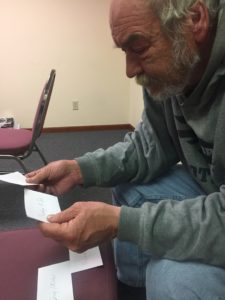
Name: Ed King
Age: 61
Time spent homeless: 8 years
Time in weather amnesty program: 3 years
Employment status: Unemployed
Blind in left eye, needs surgery to correct
Previously Vietnam veteran & in uniform business
Date of Observation: March 2, 2017
Location: Kraz Weather Amnesty Building
Type of Observation: User + Interactive Interview
Ed went through a devastating divorce and had to quit his job to enter inpatient psychiatric services. He struggled to re-enter the job market afterwards. He cannot see out of his left eye and has difficulty walking, which makes it difficult for him to find work. He needs surgery on his left eye, but does not currently have insurance that will cover it.
2. Gave up looking for work
Ed is blind in one eye and has difficulty walking. This has deterred him from job-searching, and instead he spends his time drinking on the corner.
3. Desire for Independence
Ed went through the Center for the Homeless programming, but does not want to return because he felt they interfered with his personal life too much.
4. Isolation from family
Ed’s journey into homelessness was catalyzed by a devastating divorce. His wife left him, taking the kids, home, and money. She completely shut him out of their lives, so Ed has no family in his life right now. Missing his children left him depressed and with few people to turn to.
“I wish I could put family at the top, but they’re not in the picture anymore.”
“The only thing I had was my dog and my house, but she ended up taking that too.”
“I’m 62 years old. I just gotta stick it out for 2 more years until I retire.”
“Good days are all the same. I have a couple beers a day. I never drank before, but now I’m drinking a lot more than I used to cause that’s what keeps it coherent. I don’t even know what would make a bad day anymore. They’re all bad.“
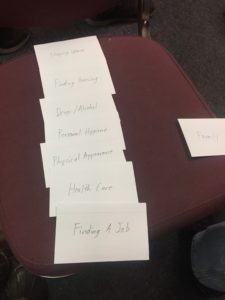
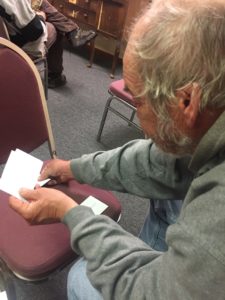
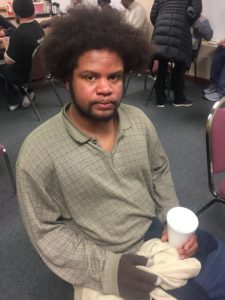
Name: Silas Elliott
Age: 27
Time spent homeless: 3 years
Current employment status: Unemployed
Has a love for pets
Date of Observation: March 3, 2017
Location: Weather Amnesty Shelter
Type of Observation: User + Interactive Interview
1. Denial of drug addiction
Silas has used drugs since the age of 14. He has been to rehab twice, but continues to use drugs. He does not think of himself as an addict, but he was intoxicated at the time of the interview to the point where he was incoherent.
2. Spending the day on the corner
Silas says he spends most of his day standing on the corner asking for money. Sometimes he also looks for work and other ways to make money, but he is currently unemployed.
3. Lacking self-awareness
Silas described himself as “hard working” and “disciplined.” This seemed to contradict his behaviors of drug use and begging on the corner.
“I was not on the verge of ‘addicacy.’ I’m not an addict, not technically. I’m like half and half.”
“My mom thinks I’m an addict. But I know that I don’t have a problem. It’s been bad before, but right now, I’m not an addict.”
“During the day, I stand on the corner and ask for money.”
Sort into words that describe you & words that do not. Rank from best to least descriptive in each category.
Words Silas believes describes him:
Words he does not believe describe him:
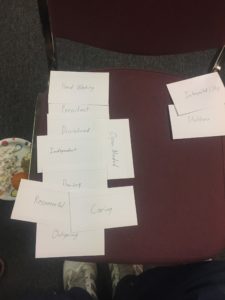
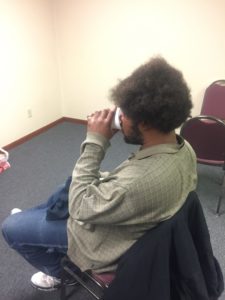
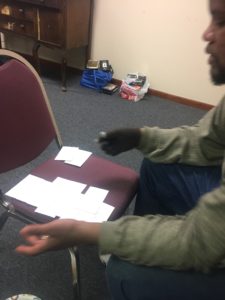
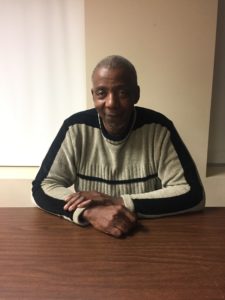
Name: David Fayne
Age: 58
Time spent homeless: 6 years
Time in weather amnesty program: 3 weeks
Hometown: Elkhart
Employment status: Unemployed
Date of Observation: February 16, 2017
Location: Kraz Weather Amnesty Building
Type of Observation: Interview
1. South Bend services are insufficient.
David previously lived in Salt Lake City and experienced the Housing First model. He feels there need to be more accessible services similar to this. He does not like that there are so many barriers to entering the shelter programs. He also dislikes that the weather amnesty shelter is temporary, and it is only accessible from 8pm to 8am.
2. The drive for improvement
David showed a passion for improving the homeless community. He dreamed of creating a 24-hour shelter/center for the homeless that would choose to help, rather than turn away, people with issues like substance abuse. He was determined to talk to local politicians, churches, and university resources about his idea.
3. Optimism for the future
David felt confident in himself that he would be able to find a job and housing soon and start implementing his ideas for improvement.
“Having a place where people could stay 24 hours would be more sufficient than spending money on these seasonal programs because we could get to deal with people and we could get to place people.”
“By people jumping around like popcorn, they’re never going to get the help they need. They’re never going to be in the facility long enough to figure out what their problem is.
“You’re gonna have to let the drug addicts in if you want to help them.”
For my immersion experience, I visited the weather amnesty shelter in the Kraz building in downtown South Bend. Below is a summary of my experience outlined in the Compelling Experience Framework:
Entice:
-No strings attached
The weather amnesty program differs from the other downtown shelters in two major ways: it is temporary (only in cold winter months) and it has very few requirements for entry. The weather amnesty is open to any homeless male, regardless of if he is drunk, high, pursuing jobs, or not. The tolerance of the shelter is what makes it so appealing for many homeless. The Center for the Homeless and HOPE ministries have requirements for anyone who enters the shelter, including a long-term commitment to their programming and staying free of drugs/alcohol. These rules can become barriers for homeless that are not ready to make those commitments.
-Provides warmth, shelter, snacks for free
The weather amnesty program provided about 30 simple cots and blankets on the floor in the back room. While it was nothing fancy, it would certainly be better than sleeping on the street. I felt safe while I was there, knowing that the staff are there to provide protection and to screen for any weapons before other homeless enter.
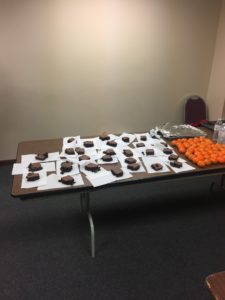
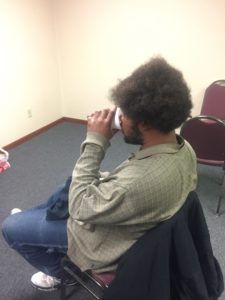
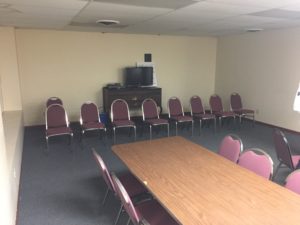
-Convenient location
The weather amnesty building is located downtown right next to the soup kitchen that provides dinner, making it a two minute, easy walk.
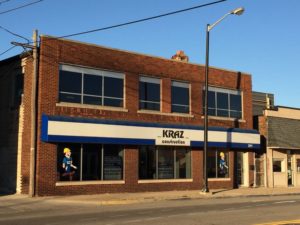
Enter:
-Staff checks for illict items
Anyone who wants to use the shelter must surrender any drugs or weapons before entering. This is for the safety of everyone in the shelter.
-Claim a cot
Typically, the homeless person will claim their cot after they enter to make sure that they get one before the shelter fills up.
-Giveaway of donated clothing items
The staff will pass out donated items, such as jeans, t-shirts, and coats, to whoever needs it.
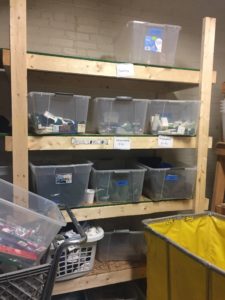
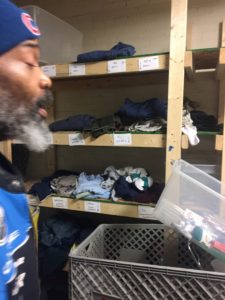
Engage:
-Snacks
-TV / VCR
-Fellowship
-Prayer & reflection led by volunteers
-Sleeping in the room
The common room was set up with chairs, a TV with a VCR, and a table for snacks. Volunteers from a local church brought in oranges, popcorn, and coffee for the snack, and they led the group in prayer. About half of the people there went to the prayer, and several specifically asked to be prayed over. The volunteers played euchre with two of the homeless men. Most other people watched TV, spent time on their phones (if they had one), or just ate their snack and kept to themselves. Some of the people there were outgoing and friendly, some were very introverted and irritable, others were high. There wasn’t a sense of larger tight-knit community, but some of the men had become friends and were chatting in the common room.
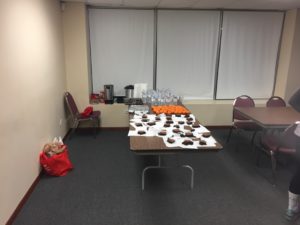

Exit:
-Leave by 8AM
All homeless must leave the building by 8am. They typically walk down the street to a local church for free breakfast.
Extend:
-Spread by word of mouth
Homeless people typically learn about resources, like the weather amnesty shelter, through word of mouth from other homeless who have used it. The people at the shelter can spread word to other people in the homeless community this way.